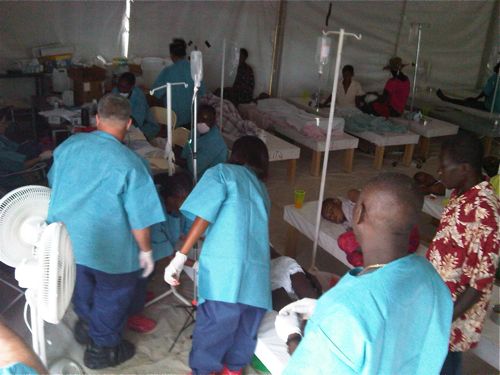
Cholera Treatment Center in Mirebalais, Haiti. Photo Courtesy Andre Paultre
On Monday the Haitian Ministry of Health (MSPP) reported 1,523 deaths and 66,593 cases of cholera since October 20 when the outbreak began in the Artibonite Department. New estimates by the World Health Organization (WHO) and the Pan American Health Organization (PAHO) indicate a possibility that the contagion could eventually affect 400,000 people. PAHO and WHO, in coordination with the MSPP and the World Food Program (WFP), have distributed 87 tons of essential medicines and supplies, but this will cover only one third of patient caseload over the coming months, according to the OCHA Cholera Situation Report #20.
The numbers are in flux and no one is certain of the absolute toll, since many isolated rural areas have no fixed reporting system.
MSNBC cited a Reuters report quoting UN spokesman Nigel Fisher that the real death toll might be closer to two thousand.
There are approximately 36 Cholera Treatment Centers (CTCs) around Haiti. The CTCs are managed by the government, NGOs (charitable organizations), or a combination of both. Often the facility is a tent complex that can isolate cholera patients away from the general hospital or community population. Emergency treatment is critical, since a cholera patient can lose up to 15 liters of fluid a day. If these fluids are not replaced, death can occur within hours. Early rehydration can mean complete recovery.
Our translator and driver, Andre Paultre, emailed us a unique glimpse into the operations of a CTC in the central plateau city of Mirebalais. Partners in Health (PIH) is working along with the Cuban Medical Brigade and the government of Haiti in an aggressive humanitarian response in this region. Mirebalais is 38 miles northeast of Port-au-Prince.
Paultre, who is Haitian, was in the area and offered a photo update on how the situation has evolved in Mirebalais. We were in the same region with him two weeks ago, but are now back in the States.
Cholera, however, will not take a break or a vacation, and over 70 health partners are responding to the epidemic throughout Haiti.
OCHA says the most affected departments are Artibonite, North, Northwest, West (including Port-au-Prince) and Northeast, although the contagion is found in all ten departments. Health cluster reports say that rural areas outside of Gonaives are seeing an increase in cases including in Petite Rivière, Perodin, and Medor.
The 36 operational CTCs translate into a total bed capacity of 2,830, and 800 more beds are planned.
Those are the numbers from the latest reports, but the numbers do not address the lack of clean water. The battle against cholera is being waged on many fronts.
A first and obvious defense strategy is to protect families at the community level by instituting water purification and hygiene awareness, OCHA says. Water treatment facilities could have slowed or stopped this outbreak, but they are not in place, so this defensive posture is what remains.
The number of Oral Rehydration Centres needs to increase rapidly. In Port-au-Prince, the issue of referral of patients has not been resolved and there is still a need to increase training of facilitators of health promotion activities... Across the country information concerning safety of various water supplies needs to be more widely disseminated. A further 4 million water purification tablets and 11,000 bars of soap is required to cover the remaining priority camps throughout Port-au-Prince for a two-week period. Security Issues in Cite Soleil are hindering response; the deprived areas of Cite Soleil urgently need additional actors and support.
In addition, there is the sensitive cultural issue of the disposition of bodies. Communities are now urged to establish appropriate burial sites in high ground at least 1.5 meters above the water table level and farther than 30 meters from water supply points.
Even more troubling are the numbers of at-risk children. According to OCHA, immediately prior to the cholera epidemic 494,600 children under 5 and 197,840 pregnant and lactating women were at risk of malnutrition and targeted for nutritional support. About 18.5 percent of the national population is under the age of 5, therefore the potential impact on this most vulnerable age group is high.
Breast milk provides a safe source of water for an infant and 100 percent of food needs until 6 months of age, providing immunity against diseases including like cholera. In Haiti 24 percent of children between 4 and 5 months are exclusively breastfed, as such they receive mixed feeding early, making them more susceptible to infections including cholera.
Valerie Amos, the UN's Undersecretary-General for humanitarian affairs, is in Port-au-Prince. She called upon the world community to provide urgently needed doctors and nurses as well as more treatment centers and supplies.
Amos said clean water is what is most needed.
